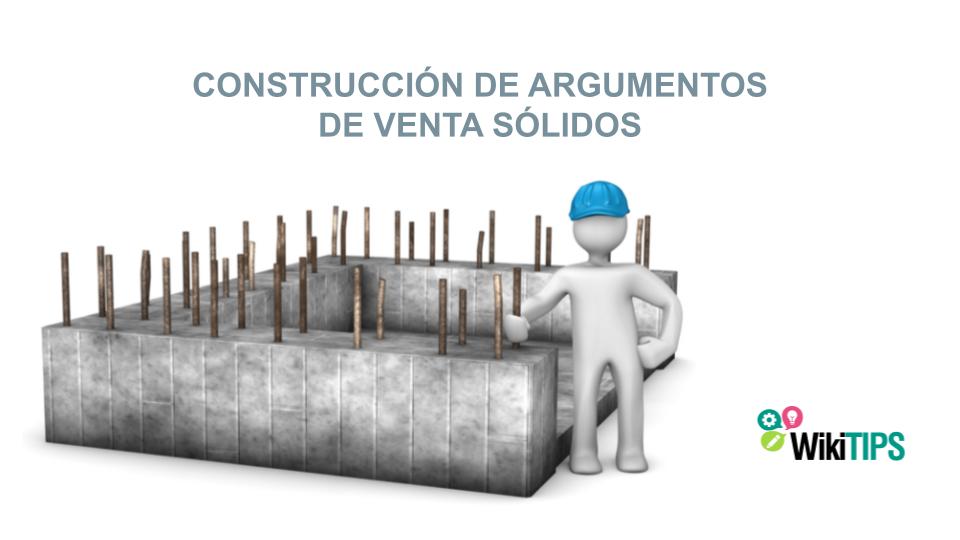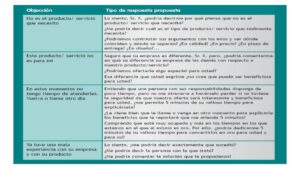
BUILDING STRONG SALES ARGUMENTS
Accelerate your business with these expert tips on "Building Strong Sales Pitches". Analyse and discover this TIP!
In this tip we are going to talk about solid sales arguments, how to develop them and how to put them together in a sales argument. One of the fundamental steps for entrepreneurs when marketing their products or services is to build a sales pitch. In this tip we explain how to develop solid arguments with a clear orientation towards the customer by assuming basic neuroscience principles.
A SALES ARGUMENTARY is a document that compiles the main reasoning that sellers of a product or service can use to convince the buyer that we offer the best option available on the market to meet their needs.
It is not a question of creating an arsenal of arguments that we will use to pressure the customer, a canned sale, but of setting out in a document the advantages and benefits of the product, taking into account the customer's profile and needs.
Sales arguments are made up of two main parts: arguments and objections and their treatment.
It is a document that is of the utmost importance because it
- Improve the technical resources of sales managers.
- Avoid improvisation in front of the client.
- Optimise the discourse they use to generate interest and conviction.
- Motivate the sales team.
- Homogenise the discourse of the entire sales team.
- Streamline customer management.
- Accelerate the process of welcoming new vendors.
- It is a document that helps reflection and the search for persuasive solutions in the relationship with clients.
Distinguish between features, advantages and benefits:
The first step in building strong sales arguments is that they must be based on meaningful benefits for the target customer.
One of the most common mistakes made by novice salespeople is to build their arguments on the basis of product characteristics. For example, when selling a car, they talk about cubic centimetres, or they talk about a string of acronyms that nobody knows what they mean. Or when we sell hardware, we talk about processors, memories, etc. In both cases, what the customer wants to hear is that I can make the product for me. In both cases, it is up to the salesperson to listen and understand the customer and then make them see the solutions and benefits we can offer them.
Normally, the characteristics of theThe advantages are underpinned by the advantages and it is clear that in products with a high technological load, hardware, software, industrial machinery, etc., the salesperson will have to talk about features when the time comes. It will be necessary to talk about characteristics when the time comes and the salesperson must be perfectly capable of answering all the doubts raised by the customer, but the real trigger for the sale is the benefits.

Reasons or emotions?
Neuroscience shows us that our brain is broken down into three: the cortex where reason and logic reside, the limbic brain that deals with emotions and the reptilian brain that deals with instincts.
In general, we all like to think that our purchasing decisions are made after careful reasoning. However, studies show that more often than we think, it is emotions and even instincts that are the real drivers of our decisions. Rather, the cortex merely provides the alibi to justify the decision.
The Bible tells us that when the serpent tempted Eve to eat the apples, he did not do so by alluding to their minerals, vitamins or fibre. He offered her to be like God. So we are talking about an emotional benefit. When insurance companies want to sell life insurance, they sell sensations, security, peace of mind in the face of any eventuality.
A salesman of business jets in the United States, recounting his experiences, said that after a hard work of rational selling of an aircraft, maintenance costs, slots, crews, fuel costs, depreciation, etc., he knew that the sale was closed when he managed to make the customer feel like a child at the controls of the aircraft.
The truth is that selling is a dynamic process in which reason and emotion play their role and the salesperson has to know how to take advantage of these circumstances. Emotion may not reside in the argumentation of the product's benefits, but it can be present in the personal relationship between the salesperson and the client.
Telesales and advertising are excellent sales schools as they teach us to structure commercial messages in a short space of time. In this link you can see a commercial video of Rational, manufacturer of the Self Coocking Center. The video is aimed at restaurant managers and, as you will see, it uses a fundamentally rational discourse: https://www.youtube.com/watch?v=XdkeXANNIEg
Rationality prevails in certain circumstances: when it comes to functional products with a high technological load and clear competitive advantages. Such is the case of Rational, whose arguments are clearly related to fundamental values for the customer: Simultaneity of dishes, speed, cleanliness, economy, etc.
Emotionality comes into play when there are no clear differentiating arguments. The wars in the beer or soft drinks sector are fought in the realm of emotions. Brands struggle to establish emotional links with the customer.
In the following you will see a spot that relates the brand to desirable values for the customer.
https://www.youtube.com/watch?v=gXfLl3qYy0k
In this link you will see what a good commercial pitch combining reason and emotion can do for a brand and a product. It is a masterpiece and a demonstration of the effectiveness of an excellent sales pitch embedded in a story. It is also a very useful example for you as an entrepreneur to build your brand while selling your product: https://www.youtube.com/watch?v=HGOrTVyo0J4
Tailor your arguments to your interlocutor:
Arguments must be conceived in terms of those who have an influence on the final decision. In this sense, we cannot deal with simple commercial processes in which we address the buyer directly, whether the buyer is a user or not. See tip on sales presentation.
We may also find ourselves in more complex situations in which the purchasing decision depends on various interlocutors with different levels of influence. This situation is typical of products or services aimed at organisations. Let us imagine that we are representatives of industrial machinery. We can find a multiplicity of independent interlocutors or grouped in a purchasing committee. Each of them has a different relationship to the object of the sale and also has different interests and needs. Therefore, each of them wants to hear different arguments:
The user might be concerned with usability and convenience, the department head with productivity or after-sales service, the financier with price and payment terms, and the SEO with strategic implications in terms of functions such as competitiveness. Even the commercial team may have something to say from the point of view of customer service improvements.
Similarly, selling to end customers is not the same as selling to intermediary agents (wholesalers, retailers, etc.). In this case we are talking about people whose essential need lies in the profitability of their business. Therefore, our arguments must be based on price, margins, discounts, promotional and advertising actions in the market, trade marketing, deadlines, etc. Arguments, as you can see, are somewhat different from those we use with end buyers: efficiency, beauty, speed, taste, prestige, design, etc.
A good sales pitch should be well structured according to the different levels of dialogue and needs, both in terms of arguments and objection handling.
How to build strong sales arguments:
These are our recommendations:
1.-Identify the sources of your arguments: Customer experience
There is a direct relationship between value and argument. The value of a commercial offer can be derived from a variety of sources. There is nothing better than an example to explain it: imagine that we are talking about a dealership that sells cars of a certain brand. The customer's need satisfier is the car itself.
It is therefore a first source of value, that we could call nuclear: the brand, the model, the design, the equipment, the consumption, the price, etc. All of them are sources of nuclear value. A second instance is given by peripheral aspects: terms of payment, guarantee, etc. A third level has to do with the seller: reputation of the dealer, treatment of the seller (friendliness, information, active listening, availability, etc.), staging, speed of delivery, after-sales service, etc.
All of these instances shape the customer's experience and should be part of the dealer's argumentation. In a competitive and undifferentiated market, the weight in the customer's decision may come from the good treatment of the salesperson rather than the design. So include everything you can do for the customer on both a tangible and intangible level.
2.-Back up your arguments with evidence that provides credibility: statistics, experiences of other clients.
Going beyond the sale.
Try to make your arguments help you build solid relationships with your customer. You must transcend the status of a salesperson and make the customer see you as an advisor, expert or even a partner: after-sales service.
4.- Emphasise your differential values. Highlight what only you can do for your client.
5.-Sell solutions, not products. Appeal to the need and demonstrate the appropriateness of your solution. Do adaptive selling.
How to build sales pitches:

The stages of the process followed by the buyer will serve as the basis for our argumentation:
1.-Identify the need and the opportunity:
Start by defining the need or problem that your customer is experiencing. This is something you have already worked on in the problem definition during the product development process. You should provide all relevant information on this in order to make it clear to the reader (management, new marketers, etc.) what the general context of your offer is.
Then describe the opportunity generated and how your product fits into it. Make it clear why your product or service is an appropriate response.
Your value proposition:
Go deeper into your value proposition. Clearly explain your value proposition in clear terms of benefits for the customer: Functionalities, problems that it solves, services that the product incorporates, etc. Try not to forget anything. It is important that you emphasise those aspects that clearly differentiate you from your competitors and make you preferable in the eyes of the customer.
Prepare for objections:
Objections always come and you have to be prepared for them. Experience is an excellent tool for identifying objections and how to deal with them. However, when you start a new activity you should do some pre-testing (sales theatre) with people who have similar characteristics to your customers.
Make a table with two columns in which you set out the statement of objections and the treatment you will give to each one. Remember that a sales argument is an organic document that must be constantly enriched by incorporating new objections that we face.

In this link You can familiarise yourself with the most common objections encountered by salespeople in general and how to deal with them, but obviously your sector will have its own specific ones. Take a good list of success stories with you so that you can use them when dealing with objections that your customers may express.
Remember that objections occur throughout the entire sales process, from the approach stage when you ask for an appointment to the closing. It is therefore advisable that your list of objections and their corresponding treatment covers all the phases.
APPLY THIS TIP TO YOUR PROJECT
TASK
Now that you have learned all about this Tip, you should be able to answer these questions:
- Could you cite your three strongest selling points?
- Cite a frequently encountered objection and write about its treatment
- How much weight do you think emotions have in your customers' purchasing decisions?
- Cite a sales pitch emanating from these instances:
- Your product or service.
- Your company.
- You as a seller.
- 💻 PRACTICE with an expert in the next practical webinar.
- 🔎 CONSULT more related TIPs with this same theme.
- 📖 AMPLIA your knowledge by downloading this EBOOK.
THINK ABOUT YOU
- 🚀 IMPULSA your company in the next acceleration programme, ¡book your place now!
- 🥁 PRACTICE with your project in this practical webinar, ¡apply for your place!.
- 🌐 CONTACT with other entrepreneurs and companies, ¡register and take part in the next Networking!
THINK ABOUT HELPING OTHERS
- 🤝COLLABORATE as a volunteer: expert, mentor, inverter, awarding, Spreading the word, challenging, innovating, creating a TIP...
- 💬 RECOMMENDS this programme to reach out to more entrepreneurs by Google.
- 👉 SHARE your learning!
- 📲 SEND this TIP 👇
Rate this TIP!
Click on the stars to rate
Rating "3" - Average " - Average5"
No votes yet, be the first to vote!
We are sorry you did not find it useful.
Help us improve this TIP!
Leave us a comment and tell us how you would improve this TIP









